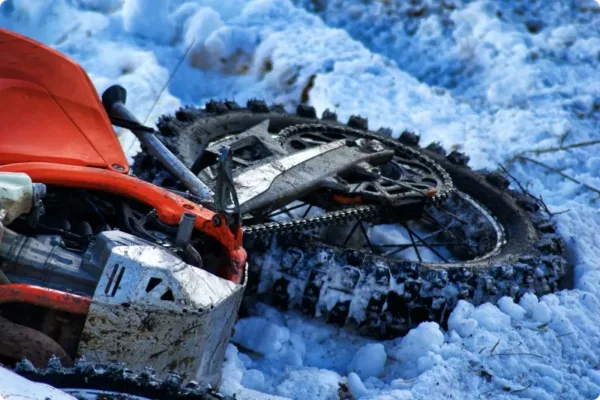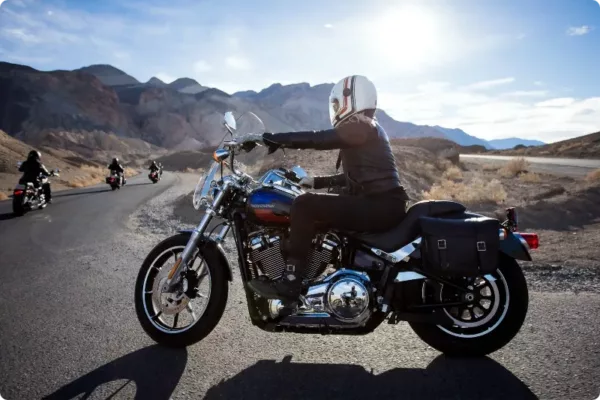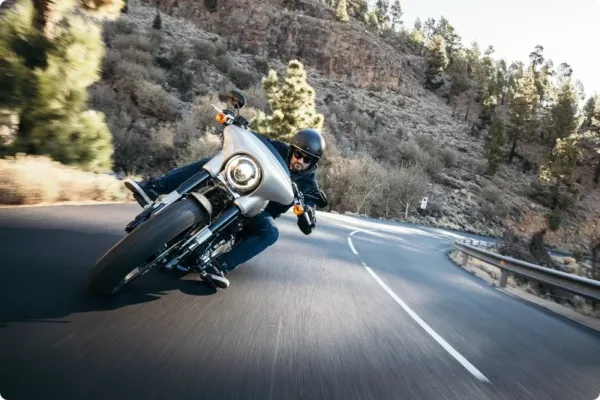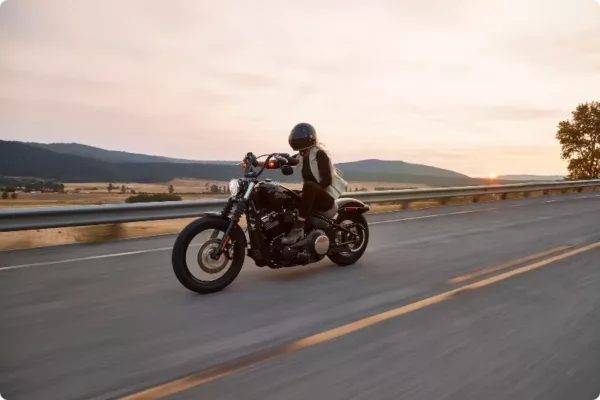Salt Lake City Motorcycle Accident Lawyer
Riding a motorcycle can be one of the most enjoyable things you do. It takes skill, knowledge, and an acute sense of awareness. Like other things worth doing, riding a motorcycle in Utah can be rewarding, but it can also be one of the most dangerous things you do.

To ensure you’re being as safe as possible, you need to know how to prevent accidents, serious injuries as well as what to do if a motorcycle accident happens.
Whether you are riding a motorcycle, moped, scooter, and riding on city streets, on dirt trails, commuting or riding for pleasure, you need to always be aware of your surroundings and take safety seriously.
Utah Motorcycle Accident Statistics

Riding a motorcycle is serious business. Many riders call cars “cages” because a cage offers certain protections that a helmet and even the most expensive motorcycle gear can’t provide.
When riding a motorcycle or even driving a car, you probably don’t think about statistics of motorcycle accidents. However, being aware of the statistics can make you a well-informed rider and even a better “cage” driver.
This everlasting motorcycle season increases the number of riders on the road and also increases the rate of motorcycle crashes. According to the Utah Department of Transportation (UDOT) motorcyle fatalities are up by 40% for 2022
Alcohol usage and motorcycle riding don’t mix. Of the fatal motorcycle accidents reported in 2019, 43% of riders who died in single-vehicle crashes were under the influence of alcohol.
It doesn’t matter how skilled a rider you are, how many years you’ve been riding, or what type of helmet you wear. If you ride intoxicated or impaired, you are likely going to end up in a motorcycle crash or in the back of a police car.
To avoid a motorcycle wreck, expensive medical bills, and perhaps a lawsuit, you need to be safe and smart all the time while operating a motorcycle. If you are in a wreck contact an experience motorcycle accident attorney like Acadia. Located in Salt lake city, Utah.
Always Wear Protective Gear

When riding a motorcycle in Utah, the gear you wear will depend on several factors such as the weather, the type of bike, how far you’re traveling, and possibly your state’s laws.
First and foremost, it’s important to wear a helmet. The National Center for Statistics and Analysis (NCSA) has calculated that wearing a helmet is 37% effective in preventing fatalities and severe injuries for motorcycle accident victims.
This means with a helmet you are more likely to survive an accident and avoid head injury. Make sure the helmet is DOT compliant and fits properly. If you aren’t sure, ask for assistance at any motorcycle apparel location.
You may also want to consider a good pair of sunglasses or tinted motorcycle visor. Helmets come in a variety of price ranges and styles. Make sure your helmet has the right fit and is high quality. Your head deserves the best, especially if it could mean the difference between life or death.
A helmet is only one part of proper riding gear. You should also have a good jacket and pants for preventing road rash. “Good” is a relative term, but think of it this way: Wear something that provides protection but is also comfortable and allows movement.
The more comfortable the gear is, the more likely you are to wear it. There are so many different types of clothing available for Utah motorcycle riders, it’s almost impossible to choose just one.
The good news is you don’t have to limit yourself to just one riding outfit. Depending on the type of bike you ride or the weather, you may need different gear for different bikes and different seasons.
Ultimately, your two main choices are between leather or textiles. Leather will offer the best protection and is generally more expensive. However, leather will outlast a textile jacket or pants.
Textiles like Gore-Tex are less expensive than leather but will need to be evaluated thoroughly since there are so many different types and uses.
Some are waterproof, while some need an additional liner to keep the rain out. You can also buy a mesh jacket for warm weather riding. Keep in mind that motorcycle gear is expensive but well worth the price when you need that extra protection in case of a motorcycle accident.

Once you start evaluating gear, you’ll find so many options for shoes that you may become overwhelmed. But just like with your jacket and pants, you’ll need to choose the shoes that fit your style of riding.
Some riders wear chunky boots made by motorcycle companies with large logos, and some riders find boots from companies that specialize in work boots.
The Utah motorcycle scene is ever changing. Today, you can even buy motorcycle-specific shoes that look like trendy skater shoes for light commuting.
Your safest bet is to cover your ankles by choosing leather boots. This will provide stability, reduce fatigue, and provide maximum protection.
Gloves are also very important motorcycle gear. A safety-conscious rider should never ride without gloves. They protect your hands from accidents and also the elements. Gloves prevent hand numbness and can help your hands maintain a proper grip of the handlebars for longer periods of time.
Take a Motorcycle Safety Course
There are many benefits to enrolling in a motorcycle safety course. Not only is it helpful in reducing the rate of getting in a motorcycle accident, but some Utah insurance companies provide discounts to graduates of motorcycle safety course programs, but some states allow you to bypass the riding part of the motorcycle test if you have proof of passing a course.
In addition, you may be able to receive discounts toward motorcycle accessories and even the purchase of a motorcycle. While these are good reasons for participating in a safety course, perhaps the best reason is the valuable experience and training you will receive.
Courses are taught by certified, experienced riders and cover state-specific rules and laws.
Ride Defensively and Safely
Learn how to ride defensively. This means paying attention to how you’re riding, as well as where you are riding. Make sure you are aware of road conditions. Don’t follow other vehicles too closely, and in bad weather be sure to increase the stopping distance.
At stop signs or lights, make sure to pull slightly off center so you have an escape route should a negligent driver behind you appear to be coming too quickly. Some motorcycle riders even go as far as to ride exclusively in the slow lane (typically the far-right lane) so they always have an escape route.
Being safe on a motorcycle is also about following traffic rules, preventing a motorcycle accident and being visible to other riders and vehicles. A safe motorcycle rider pays attention to the weather, dresses appropriately, and knows visibility can be affected by the rain and also the sun.
Pay Attention to Your Surroundings
Riding a motorcycle takes concentration and an acute awareness of your surroundings. A good rider learns how to tune everything out except for what’s around them and their bike.
They learn to see where the cars are at all times and to anticipate what the car drivers are going to do. Experienced motorcycle riders also look ahead for any potential obstacles on the roadway.
Hitting a rock that’s on the asphalt in a car can be uncomfortable. Hitting one while riding a motorcycle can be a deadly motorcycle accident.
Ride a Roadworthy Bike That Fits

One of the most important things motorcycle riders need to do is ensure they have the right bike. Are you short? Get a bike with a lowered seat. Are you a beginner? Don’t buy a bike with a lot of power that you don’t need and won’t use.
Are you planning on riding off-road? Look into purchasing a bike that can handle that type of riding. Are you commuting only a few miles in the city? Consider a scooter. Scooters have enough power for city riding, they are easy to park, and they’re fun to ride.
After you have found that perfect motorcycle, get to know the bike and perform safety checks on a regular basis. Check the tire pressure and tread, and make sure the brakes and lights are working properly.
If you see any leaking fluids, make sure they are quickly fixed. Riding safely is much more than simply knowing how to ride. It’s also about taking care of your motorcycle and performing regular maintenance.
If you are a rider who doesn’t perform maintenance on your own bike, then make sure you are following the manufacturer’s guidelines for professional maintenance. Following all these safety tips are key to reducing the likelihood of a motorcycle accident.
Ride Sober

Riding while impaired, either from alcohol or drugs, is never a good idea and it’s against the law. Make sure you are completely sober when riding and keep an eye out for fellow riders as well. You might think that a few drinks won’t affect you, but statistically, this just isn’t true.
Alcohol limits your ability to think clearly and reduces reaction time, which certainly affects your ability to safely operate a motorcycle which can turn into a deadly motorcycle accident.
What to Do If You’re Injured in a Motorcycle Accident?
Sometimes, no matter how safe and prepared you are as a rider, motorcycle accidents happen. When it does, you need to make sure you know how to react and how to protect yourself. What to do depends on the extent of the accident and if other people or vehicles are involved.
The first thing you should do in the event of a motorcycle accident in Utah is to make sure you are out of danger. Move out of the roadway before doing anything else. Make sure you aren’t near any vehicles that may be leaking fuel.
Stay out of any blind spots, such as corners or behind other vehicles that may block others from seeing you. Check yourself for injuries and call 911 if needed. Unless you are a doctor, don’t self-diagnose. If you’ve had a significant crash, go to the hospital to have your injuries evaluated.
Stay as calm and rational as possible. Don’t make things worse by getting angry or pointing blame, and don’t volunteer to accept blame. Obtain information from all involved parties and witnesses including statements, names, and phone numbers.
If you’re able, it’s always useful to exchange information as well as take photographs of license plates and people involved. Wait for the police and record the details of the accident to the best of your ability.
Make sure you obtain the police officer’s information so you can easily contact them later if needed to request a copy of the report.
As a motorcycle accident victim, there may be times when you need legal assistance after a Utah motor vehicle accident. Don’t hesitate to contact a law firm if you need one. A motorcycle accident attorney in Utah may be necessary if there is personal injury, your insurance claim is denied, you don’t receive proper medical benefits, or if the damages exceed the limits of your insurance.
Common Motorcycle Accident Injuries:
Motorcyclists face an increased risk of injury due to the lack of protection compared to a traditional four-wheeled vehicle. Common motorcycle accident injuries sustained by riders include:
Head and Brain Injuries: Motorcycle accidents often result in severe head trauma, including traumatic brain injuries (TBIs) that can cause long-term disability or even death.
Neck and Spine Injuries: Neck and spine injuries are common among motorcyclists and can lead to long term health complications as well as lasting pain and stiffness.
Road Rash: Road rash is a type of skin abrasion caused when riders come into contact with the ground at high speeds. Severe road rash can require extensive medical attention and may leave permanent scarring.
Broken Bones: A motorcyclist who is thrown from the bike or slammed into another vehicle can suffer broken bones such as fractures or dislocations. These types of injuries may require surgery or other medical interventions in order to heal completely.
Internal Injuries: High speed motorcycle accidents can result in severe internal organ damage, which may be difficult to detect immediately following the crash. Internal bleeding, hernias, and organ damage are all potential consequences of a motorcycle collision.
Spinal Cord Injury: Motorcyclists are particularly vulnerable to spinal cord injury due to their exposure to the elements during a crash. Damage to the spine can lead paralysis – either temporary or permanent – below the affected area of the spine.
Acadia Law Group – Salt Lake City Motorcycle Accident Lawyer
It’s always wise to talk with Utah motorcycle accident attorneys about any possible legal ramifications of your motorcycle accident, especially if you need fair compensation for your pain and suffering. If anyone involved with the accident contacts you, refer them to your motorcycle accident attorney. As much as you may want to discuss things, it’s always better to have an attorney do the talking.
It’s important to understand that there are many safety factors to consider before you even ride a motorcycle in Utah. You need to ensure you have the proper gear, a bike that fits your needs and your size, and you also need enough experience to ride safely and smart.
Riding a motorcycle may be one of the most rewarding things you ever do. There is a freedom to riding that can’t be matched in a car, wrapped in metal sitting comfortably in a seat. Imagine riding down a rural road, the breeze on your face, the smell of fresh strawberries in the fields you pass.

All your daily worries will disappear as you focus on the road in front of you. Just remember that your safety is the most important thing, followed by knowing how to get assistance when you need it. Contact us at Acadia Law Group to schedule a free consultation! Let us get you the compensation you deserve!


